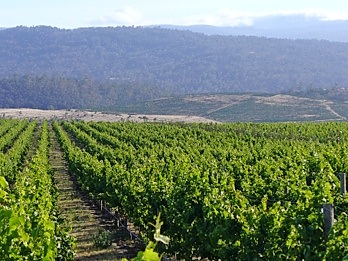When it comes to Australian pinot noir, three wine regions stand tall: the Yarra Valley, Mornington Peninsula and Tasmania.
With Mornington and the Yarra just up the road, we’re lucky their wines are so accessible. Tasmania, on the other hand, feels like the final frontier for pinot noir.
A quick browse of a wine list in Hobart or a shop in Launceston can feel like a walk through Aladdin’s cave for a pinot lover, with unknown wines at every turn.
At the moment there are about 160 wine producers in Tasmania, but only 60 or so send wines to the mainland. Demand for local wine in Tasmania is so strong that many producers don’t need to send the wines over Bass Strait. There’s the odd occasion when a pinot will make it onto a single Melbourne restaurant’s wine list because the sommelier is a friend of the winemaker or has helped out at the winery during the vintage harvest.
All the big wine companies want a pinot noir in their portfolio from the state that produces just 0.5 per cent of Australia’s wine. From big corporates such as Accolade Wines (Bay of Fires and Arras) and Treasury Wine Estates (Heemskerk and Abel’s Tempest) to family-owned producers such as Brown Brothers (Devil’s Corner) and Shaw + Smith (Tolpuddle), they all have a foot in the door.
Pinot noir is the state’s most widely planted grape, but there’s not all that much pinot to go around – just 5000 tonnes of pinot noir grapes were picked in 2013. A large proportion of that went into sparkling wine production.
To put this volume into perspective, there are wineries in the Barossa and Riverina that can process more than Tasmania’s annual pinot noir crop in a day. Despite all the interest from mainland producers, there hasn’t been a huge investment in wine infrastructure and many large producers ship grapes to the mainland to be processed at their wineries. Others ferment and crush their grapes on the island and ship the juice to their wineries to finish the maturation process.
So why does everyone want a piece of Tasmania’s pinot noir pie? Tasmania is considered a marginal climate for growing grapes and its cool days mean grapes take a long time to ripen. Extra time on the vines helps them develop deeper flavours while retaining acid levels.
Many Tasmanian wineries harvest their pinot into May, while most mainland pinot-producing regions have their wines fermented and tucked away for a rest in oak barrels by then. The further south you go, vineyards tend to be planted on sheltered or north-facing sites that give them enough sunlight to ripen. Still, it’s not guaranteed the grapes will ripen properly.
Tracking down Tassie pinot noir
You don’t need to visit Tasmania to track down its elusive pinot noir. Buy direct from the wineries or check out the Pinot Shop, run by Michele Round. Round regularly secures allocations of pinot from Tasmania’s smallest and most sought-after pinot noir producers. Based in Launceston, Pinot Shop has a range of mixed pinot cases and ships to the mainland for $14 a case.
Ben Thomas travelled to Tasmania as a guest of Heemskerk








